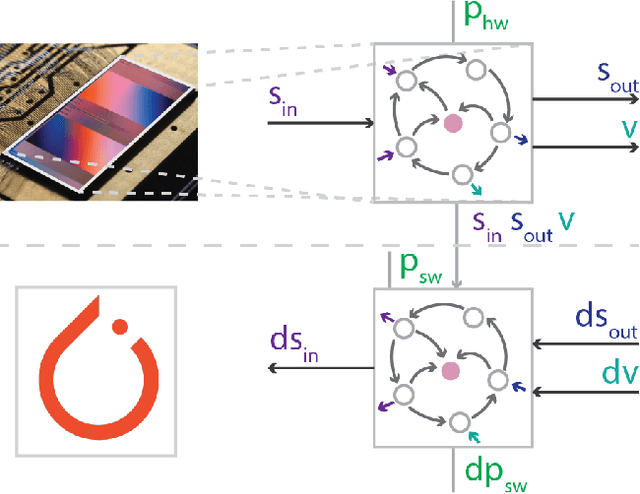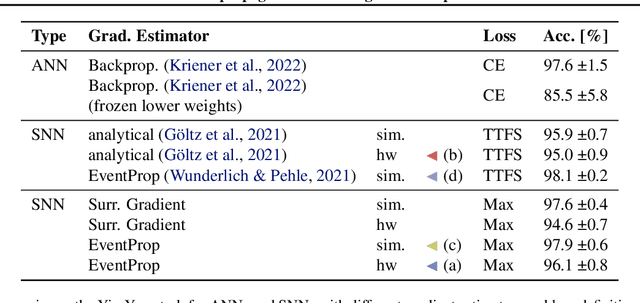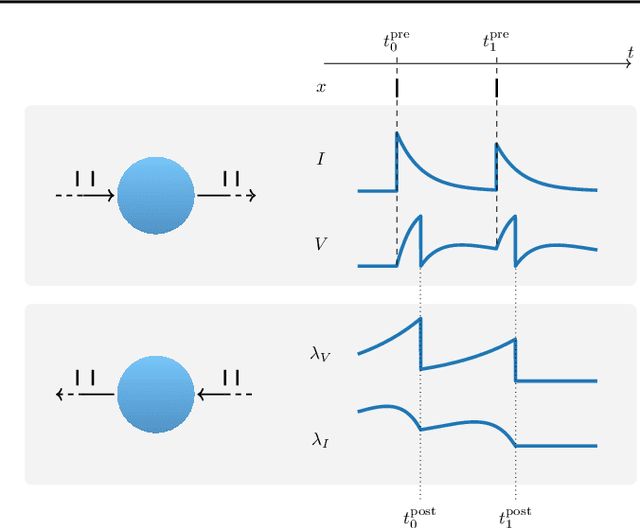Luca Blessing
Event-based Backpropagation for Analog Neuromorphic Hardware
Feb 13, 2023



Abstract:Neuromorphic computing aims to incorporate lessons from studying biological nervous systems in the design of computer architectures. While existing approaches have successfully implemented aspects of those computational principles, such as sparse spike-based computation, event-based scalable learning has remained an elusive goal in large-scale systems. However, only then the potential energy-efficiency advantages of neuromorphic systems relative to other hardware architectures can be realized during learning. We present our progress implementing the EventProp algorithm using the example of the BrainScaleS-2 analog neuromorphic hardware. Previous gradient-based approaches to learning used "surrogate gradients" and dense sampling of observables or were limited by assumptions on the underlying dynamics and loss functions. In contrast, our approach only needs spike time observations from the system while being able to incorporate other system observables, such as membrane voltage measurements, in a principled way. This leads to a one-order-of-magnitude improvement in the information efficiency of the gradient estimate, which would directly translate to corresponding energy efficiency improvements in an optimized hardware implementation. We present the theoretical framework for estimating gradients and results verifying the correctness of the estimation, as well as results on a low-dimensional classification task using the BrainScaleS-2 system. Building on this work has the potential to enable scalable gradient estimation in large-scale neuromorphic hardware as a continuous measurement of the system state would be prohibitive and energy-inefficient in such instances. It also suggests the feasibility of a full on-device implementation of the algorithm that would enable scalable, energy-efficient, event-based learning in large-scale analog neuromorphic hardware.
hxtorch.snn: Machine-learning-inspired Spiking Neural Network Modeling on BrainScaleS-2
Dec 23, 2022Abstract:Neuromorphic systems require user-friendly software to support the design and optimization of experiments. In this work, we address this need by presenting our development of a machine learning-based modeling framework for the BrainScaleS-2 neuromorphic system. This work represents an improvement over previous efforts, which either focused on the matrix-multiplication mode of BrainScaleS-2 or lacked full automation. Our framework, called hxtorch.snn, enables the hardware-in-the-loop training of spiking neural networks within PyTorch, including support for auto differentiation in a fully-automated hardware experiment workflow. In addition, hxtorch.snn facilitates seamless transitions between emulating on hardware and simulating in software. We demonstrate the capabilities of hxtorch.snn on a classification task using the Yin-Yang dataset employing a gradient-based approach with surrogate gradients and densely sampled membrane observations from the BrainScaleS-2 hardware system.
 Add to Chrome
Add to Chrome Add to Firefox
Add to Firefox Add to Edge
Add to Edge